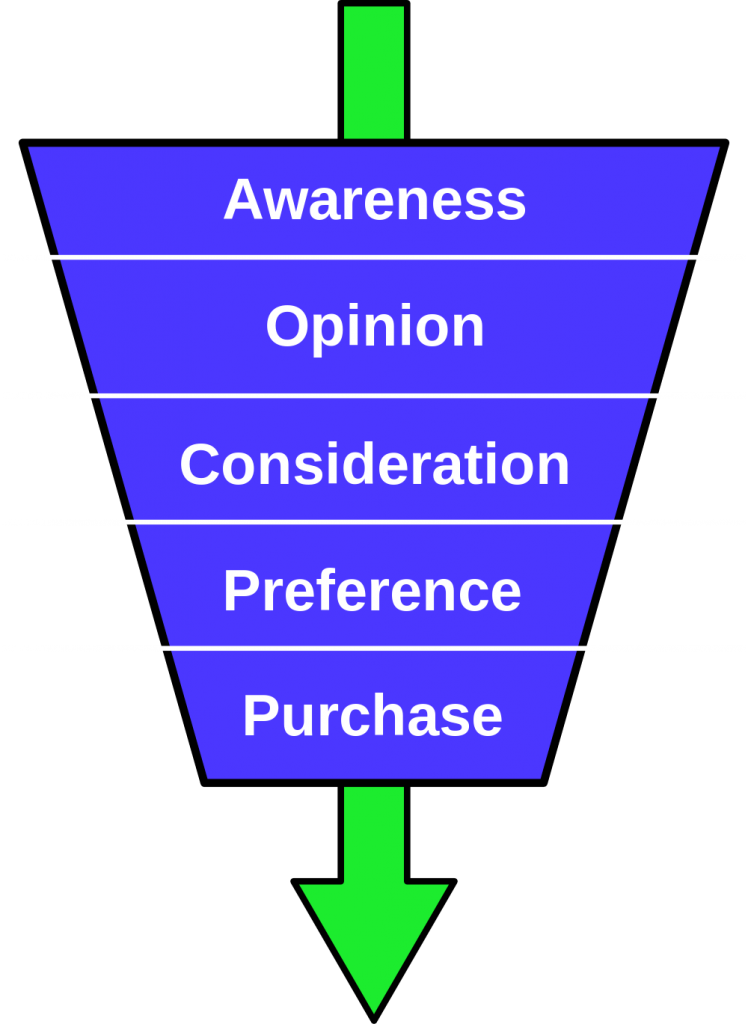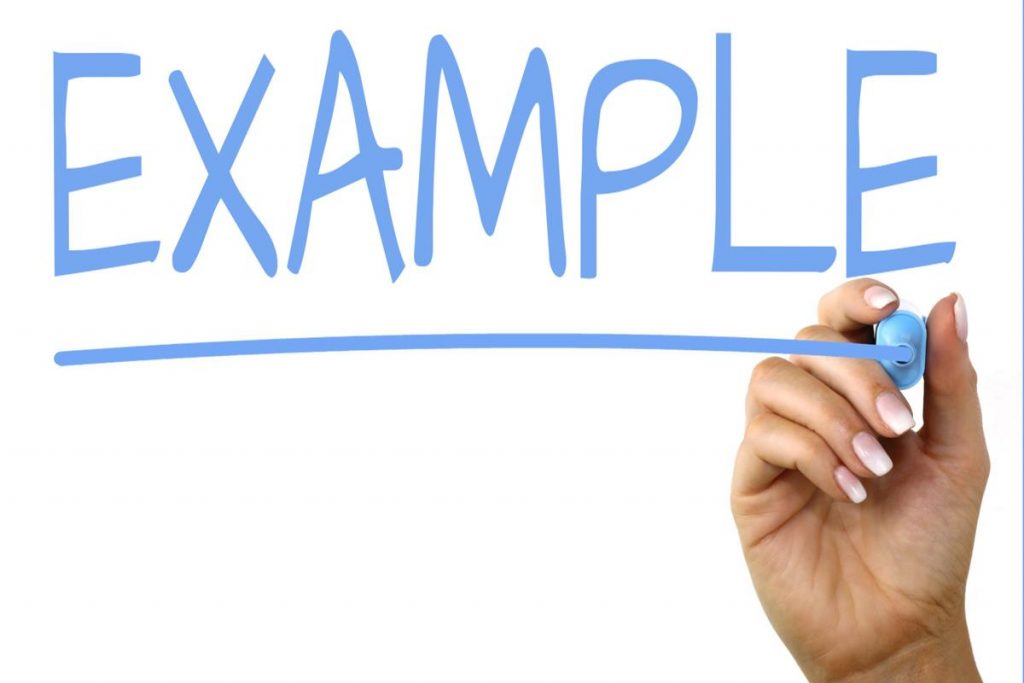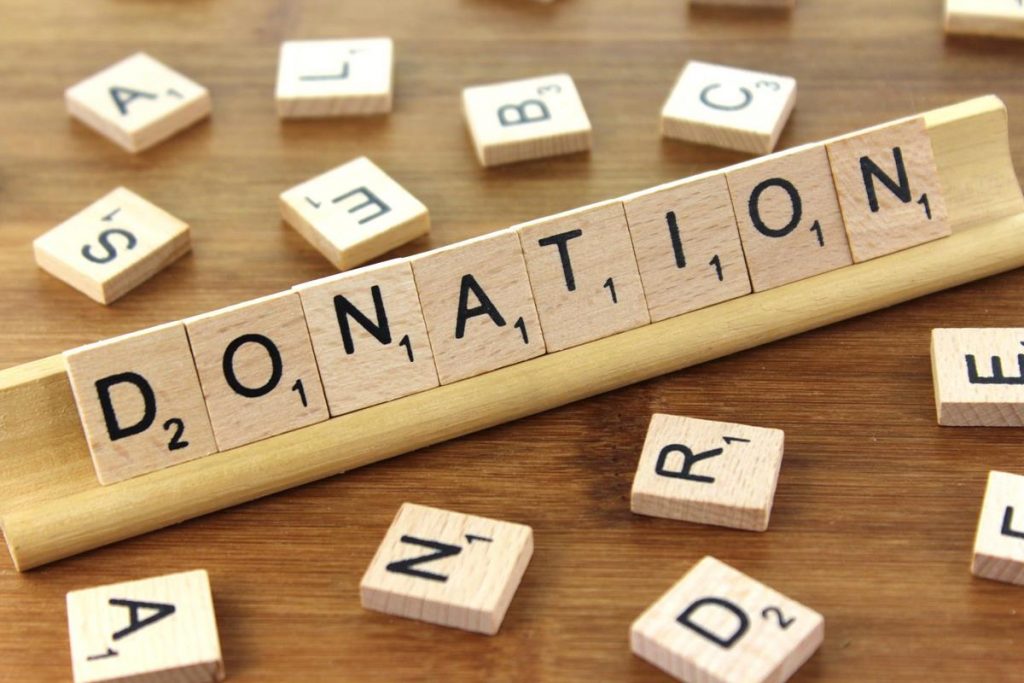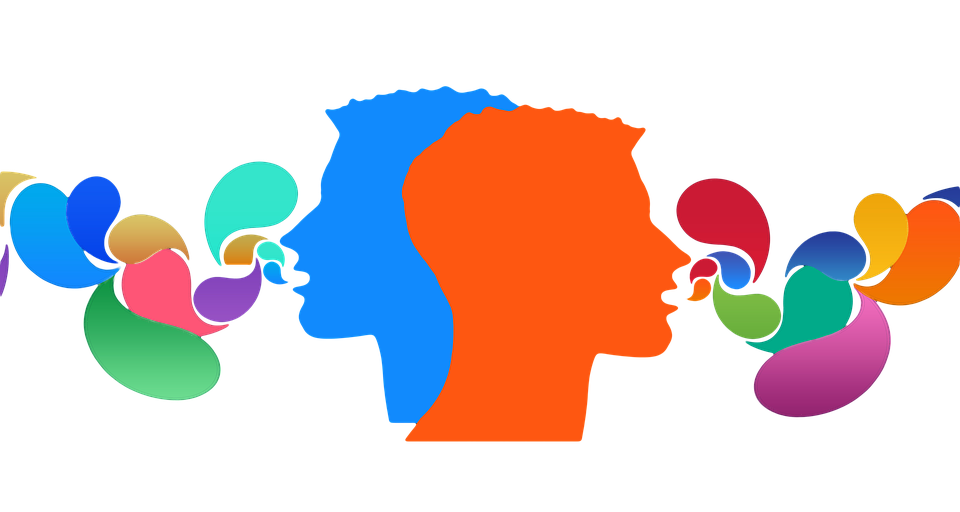In order to gain more donations and inspire volunteers, it is critical to understand the fundamental concept of a marketing funnel.
Many non profit marketing campaigns make the mistake of launching without understanding the funnel and how it relates to potential donors.
Here’s how non profit marketing funnels work:
The Most Important Aspect Of Non Profit Marketing – The Funnel
For the purposes of list building, you need to understand the fundamental concept of funnels.
Marketing funnels refer to the different stages of a donor.
Starting from someone who’s shown potential interest – to someone who is donating and getting involved with your organisation.
The image above depicts the classic marketing funnel.
This funnel was developed originally for businesses, but it can be easily adapted to non profits too.
Let us walk you through the 5 main stages of the funnel.
Imagine the funnel as a process starting from when a person first hears about your organisation – to becoming an engaged donor.
Non Profit Marketing Funnels Explained
Stage 1: The Awareness Stage
- Here, the person has just become aware of your organisation on the surface level.
- This may have happened through a Google search, Youtube video, Social Media etc.
- At this stage, they have no intention of donating or getting involved. They are just gaining basic awareness of your existence
Stage 2: The Opinion Stage
- After they have become aware, they are now building an opinion about your organisation.
- They are developing opinions on what you do, why you do it, the size of your organisation etc.
- For online purposes, most of this information is gathered from your website’s About pages, Blog post / articles and other content.
- To influence those in the opinion stage, content is extremely important.
Stage 3: The Consideration Stage
- At this stage, they are now considering whether they want to get involved or donate to your cause.
- Regular communications is KEY at this stage to keep the person from losing interest
Stage 4: The Preference Stage
After the person completes their consideration stage and has decided to get involved (whether through donations or volunteering), they now begin to “shop around.”
They are now looking at other non profit organisations and trying to decide if they want to commit to yours.
This is where your USP (Unique Selling Proposition) comes into play.
- As a non profit, you still need to engage in the “sales” process. This is because you need to “sell” your donors on the idea that donating is a better use of money than spending it on other things.
- Your USP is the unique reason why your non profit is different from other non profits. But it must be framed in a way that is beneficial to the donor.
- For example, a non profit USP might be that you provide extreme transparency and regular reports on how and where your donations are spent. This is beneficial for the donor because many of them worry about how their money will be used.
- However, saying that your cause / mission is more important than other non profits because of X or Y statistic, how many people it affects etc. is not a USP. It is not unique (because every NFP can say the same), therefore not a USP.
- You’ll need to think deeply about how to frame your USP to those in the Preference Stage. It will determine whether they become a donor for your organisation or someone else’s.
Stage 5: The Purchase Stage
- We would rename this stage the “Donation Stage” for the purposes of non profits.
- This is the final stage by which they donate / volunteer for your organisation.
- It is important to continue to maintain regular communication and remind people in this stage, why they should stay with your NFP.
- This stage is where you focus on donor retention.
Illustration Of How The Non Profit Marketing Funnel Works
Let’s say you have 100 people visiting your website who have never heard of you before. Here’s how they travel through the funnel.
(Please note that these numbers are arbitrary – they are just guidelines to outline this example):
Stage 1: Awareness (100)
All 100 people start on the awareness stage.
They hear about you one way or the other and decide to find out more.
But out of the 100, only 80 decide to find out more.
Stage 2: Opinion (80)
Now we only have 80 people left out of the original 100. These people are now trying to form an opinion about your organisation.
They will read / view the content on your website and form an opinion based on what you tell them.
Of course, this is why you need to have updated and engaging content on your website to influence people in the Opinion stage.
Stage 3: Consideration (30)
Of the 80, only 30 decide to form an opinion. The other 50 people found it too much effort or weren’t engaged effectively. They decide to do something else with their time.
There’s a huge drop in the total audience here because this is what happens in the real world.
People will not tolerate boredom. They’d rather do other things. They usually don’t want to expend much effort to do anything.
That’s why only 30 are left in the consideration stage.
These 30 people will now leave your website and go about with their daily lives.
If you have not managed to establish some form of communication channel (e.g. email, social media etc.) at this stage, you will lose all 30 people.
This is because almost nobody will come back to your website out of their own accord. They must be prompted and reminded through communication from you.
Without an email address or social media connection, this is impossible to do.
Stage 4: Preference (10)
Out of the 30 in the consideration stage – if you have maintained regular communication with these people and got them to come back, 10 will enter the preference stage.
The other 20 have dropped out because they didn’t feel a strong enough need to continue.
They either weren’t engaged enough or didn’t feel connected to your cause.
This stage is where your USP (mentioned above) needs to convince people to contribute to YOUR cause and not others.
You are competing for the limited resources of the person – against other non profits who are all vying for the same donation money.
That’s why you need to convince people to commit to your non profit.
It’s important to note that people may search around on Google or ask friends / colleagues to look for potential competitors.
When they do this, they enter the funnel of another NFP – starting again from Stage 1 (awareness) all the way to Stage 5.
Conversely, it also means that you can “capture” people from other NFP’s funnels as they “shop around.”
If you do a good job of crafting and framing your USP, you may end up increasing the number of donations you get.
Stage 5: Donor (2)
Out of the 10 in the Preference Stage, only 1-2 will become donors / volunteers.
Why are there so few people left?
There are several possible reasons:
- They weren’t convinced of your USP and reasons on why they should contribute. You’ll need to hone your copywriting and marketing skills in order to achieve this.
- Got interrupted by something while they were making the decision. This is why it is so important to maintain regular communication. It’s easy to get distracted (especially online) so you need a way to bring their attention back to your organisation.
- They got cold feet at the last moment. People generally don’t like to engage in things that change their lives. They like to maintain the status quo.
- Financial constraints
The first two points, you can take action to make a difference. But with reasons #3 and #4, there isn’t much you can do about it.
Why Do So Many People “Drop Out” Of The Non Profit Marketing Funnel?
At each stage, you may have noticed many people “dropping out” of the funnel completely.
Now these numbers may seem extremely low to you. Essentially since we’ve started from a 100 visitors down to just 2 donations.
In reality, the numbers are MUCH worse.
You could have a 1,000 visitors and have no donors at all. It depends heavily on the quality of the visitors and the engagement you develop with your content / communications.
A highly-performing, profitable online business would generally be happy with a 2% conversion on their visitors (i.e. turning them into customers).
For non profits, the numbers are likely going to be much lower because you have to sell people on an idea / cause – instead of a product / service that directly benefits the customer.
It’s a bigger challenge which is why most non profits are always strapped for funds.
But there’s hope yet – here’s what you can do to improve retention at each stage of the funnel:
Shift These Numbers By Using A Different Strategy For Each Stage Of The Non Profit Marketing Funnel
Each stage of the funnel must be improved with a different strategy.
We have a wealth of resources you can use to better each part of the funnel.
Because it can get overwhelming, we recommend you focus on 1 stage at a time.
Improve the Awareness Stage
The best way to improve the awareness stage is to simply have more qualified traffic (visitors) entering your funnel.
This could be through the $10,000 Google Adwords Grant, Facebook Advertising, Social Media, SEO (getting ranked highly in Google Search) and more.
We have written articles that discuss building traffic at length:
- Ultimate Beginner’s Guide To Building Your Online Presence As A Non-Profit Organisation – Part 1
- Ultimate Beginner’s Guide To Building Your Online Presence As A Non-Profit Organisation – Part 2
- How NFPs Can Create Engaging Facebook Content That Gets More Shares And Likes
- How To Get The Most Conversions Out Of Your NFP Website When Advertising Online
Improve the Opinion Stage
The best way to improve the opinion stage is to deliver engaging content.
You should have a clear message on your homepage / about page on what your organisation does, why it is important and why the reader should support you.
It is also important to have updated, fresh content on your website in the form of blog posts, videos etc.
We have an article on the Top 10 Tips That Will Help Your Articles Get Read And Shared you can refer to and produce engaging content.
Improve the Consideration Stage
To get more people to stay with your organisation during the consideration stage, regular communication is key.
And of course, to communicate regularly, you must have their email or other contact details.
We recommend having a form or popup on your website that asks for people’s emails in exchange for information that would be valuable to them.
For example, you could provide a report that shows how your organisation uses resources, why you’re different from other non profits etc.
To understand what kind of information would be valuable, you need to talk and ask questions to your current donors / volunteers.
Ask them:
- What made them want to get involved with your organisation?
- Why did they choose your cause over other worthy causes?
- How did they hear about your organisation?
- Are they involved in any other non profits?
- What made them want to donate?
These are a few examples of questions you should ask your donors in order to understand where they’re coming from.
For general information on what donors want, use this survey that discovered what donors want most.
Donors say that:
- They want acknowledgement that their gift or donation was accepted with one-on-one communication (e.g. phone call or personal postcard)
- They wanted to be assured that their contribution would be used effectively and carefully
- They wanted to know that projects / programs were making a positive impact and making a difference
If these conditions are met, donors say that:
- 87% would donate again
- 64% say that they would donate more
- 74% say that they would continue to donate
So as you can see, maintaining regular communications is the backbone of getting more donors to consider your organisation’s cause.
But what should you email them?
In the initial first contact stage, we recommend setting up an email “autoresponder” sequence. This is basically a series of emails that get sent out automatically to anyone who joins your list.
Autoresponders can be set up using email services like Mailchimp, AWeber or Getresponse.
We recommend sending out a 5-7 email sequence for those in the consideration stage who have just joined your list.
These should be sent out daily as you need to keep contact very often with those in the consideration stage (or they will forget about you).
Each email should be around 200-300 words, contain little or no images at all and focus purely on conveying stories.
Write interesting subject lines that are likely to be opened. Use elements of curiosity to increase email open rates.
Each story should get the donor to get a little “closer” to your organisation and understand your key values and mission.
For example, you could talk about:
- How and why your NFP was created
- How you (personally) got involved
- A story about an individual that you’ve helped (with their permission)
- A story about a donor who got involved (with their permission)
- A story about how and why a volunteer got involved
Each email should end with a link to your website where they can learn more about how they can donate or volunteer etc.
Link directly to a page dedicated to persuading people to get involved with your NFP (provide reasons why, tell them where their money will go, how it will be used, prior facts/statistics on how your organisation has helped people etc.)
Do not make the mistake of linking to your homepage and expecting people to find this “why you should donate” page on their own!
Here are some additional tips on how to write engaging emails:
- Start every email with an engaging story that will help the donor understand what your NFP is about and why it is important to donate
- Keep the emails short – around 200-300 words. Primarily text only.
- Try to introduce each story with a person. Explain the challenges this person experienced and how they overcame these.
- After the story, segway to the main reason why the donor should get involved. You can do this by using phrases like:
- “All of which brings me to this point…”
- “Case in point…”
- “This is why…”
- Try to inject some entertainment / humour into your stories (where appropriate). People respond best to entertainment.
- Make sure you use short sentences in the active voice. You can use the Hemingway Editor to ensure your email is easy to read. Aim for Grade 5 – 6 level in the editor.
- Always end the email with a link to your dedicated “why you should donate” page
- Make sure you set up the autoresponder to send these daily. People easily forget and if they have a problem receiving daily messages from you – they can always opt out. These people would never have become your donors anyway.
If you’d like more tips, we recommend reading our article here:
How NFPs Can Develop Better Relationships With Donors And Boost Donations
Improve the Preference Stage
Improving the preference stage is using a mix of the tactics from Improving the Consideration Stage (constant communication) and developing your USP.
As explained, your USP (Unique Selling Proposition) provides the unique reason why your organisation is different from other NFPs – framed in a way that is beneficial to the donor.
The key point is that the USP needs to satisfy the donor with some specific benefit that other non profits don’t provide.
For example, most donors want transparency and to know how their money is being used effectively. Your USP then could be, you provide regular monthly email reports that are personalised to show exactly how that donor’s money has been used.
However, saying that there’s no other NFP that serves the mission you have is not a USP. This is because this is not framed in a way that is beneficial to the donor.
The donor does not benefit from the fact that only your organisation serves X individuals that need help.
Additionally, saying that your mission or cause is the most important (or critically important) is also not a USP.
This is because it is not unique. Every non profit will say the same thing, therefore it is not unique enough to stand out.
Try to think about how your non profit can serve both the mission / cause AND the donor at the same time.
Improve the Donor Stage
You can improve the donor stage by making tweaks to your autoresponder email sequence (from the Consideration Stage).
Plus you can spend more time improving your dedicated “why you should donate” page.
These factors are the most important in persuading people to become donors for your organisation.
If you’d like to learn more about how to intertwine stories with emails on a daily format, sign up to Ben Settle’s email list. He sends daily emails, usually in a story format. Though his focus is on email marketing and business, you can still apply the lessons to your own emails.
Read the free copy of his “Email Players” Newsletter as it contains valuable information on how to write better emails.
In Conclusion
We hope you found this article useful in understanding and developing a marketing funnel for your NFP.
We recommend using this as reference material and taking one section at a time.
The most important part to focus on is the Consideration Stage. Having a way to capture potential donor / volunteer email addresses is key.
Then set up an autoresponder sequence with 5-7 daily emails that tell stories. Make sure to spend some time crafting a dedicated “why you should donate” page.
Doing this alone will drastically improve the amount of donations you receive.
Need help setting up your website, email forms and autoresponders?If so, get in touch with us.
We’ve specialise in helping non profit organisations develop their online presences.




